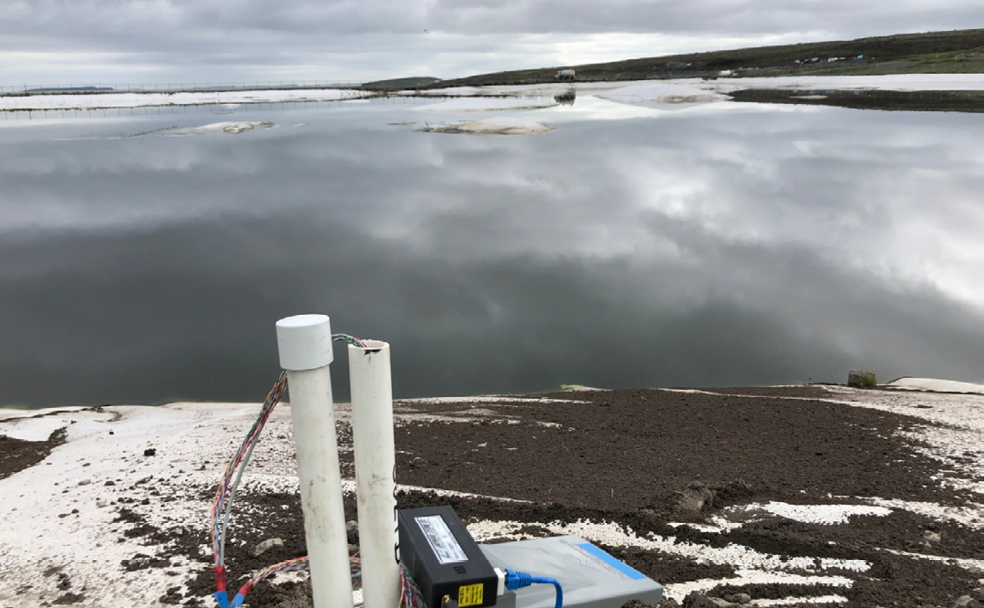Continuous recording of temperature data is a method of monitoring the operational performance of sewage lagoons constructed on permafrost in the Canadian Arctic. Factors that impact the performance of these lagoons include the condition of the permafrost prior to construction and after the structure is built, and changes in the permafrost that result from warming caused by the contained sewage.
Furthermore, drainage around the lagoons, as well as subsurface water around and below them, impact asset performance. Both flowing and standing water contribute to melting of permafrost.
A study was completed by EXP for the Government of Nunavut on the Kugluktuk sewage lagoon, which has historically been plagued by leakage and a malfunctioning liner. The study involved installing temperature monitoring equipment into berms and data collection, as part of a 2021 field program.
The Kugluktuk lagoon is a rectangular engineered pond, lined with 60 mil (1.52 mm) thick high-density polyethylene plastic. It is approximately 240 by 200 metres in size, with compacted granular earth berms, and was designed to store 125,000 cubic metres of sewage for a 12-month period.
The treatment process allows this facultative lagoon to passively function over the period of warmer and sunny Arctic summers and discharge into an adjacent wetland for supplementary treatment in the fall. The lagoon was constructed on top of a natural drainage course that crossed the area.
The goal of the 2021 field program was to collect data that could be used to assess the geotechnical elements of the lagoon and develop a plan to improve issues with it.
The lagoon was commissioned in 2009, and several issues started occurring in the first year of its use, which became obvious over time. These issues included: a floating liner that formed “islands” (also referred to in the industry as “whales”), which started forming after construction in 2009; lagoon leakage under one of the berms in 2010; and significant subsidence of the earth berms progressing over time. In one location the berm subsided over 40 centimetres.
Four holes were drilled around the top of the lagoon and polyvinyl chloride tubes were installed in the holes. Wires with electronic thermometers at several places along the wires (thermistor strings) were put into these tubes and connected to equipment in protective cases.
This system continuously recorded the temperature of the earth around the tubes. A multimeter, which recorded details such as voltage, current and resistance, was also connected to the thermistor strings to do spot-check readings at various times and spots.
Water levels in the holes were measured at several locations along the berm with a water level meter. This information was added to information on the temperature distribution in the earth berms on the north and west sides of the lagoon. The ground temperature measurements revealed similar temperatures between the holes, suggesting that the ground below the berms was frozen and the base of the berms was freezing back.
Upon completion of the 2021 field program, a decision was made to leave a data logger connected to a thermistor string on site for further data collection. In March 2022, data from the data logger, which had been recording since August 2021, was downloaded. The recorded temperatures confirmed that the ground was frozen to at least four metres below the base of the berm in this location.
Temperature data recorded in 2021 and during the follow-up in 2022 provided valuable information about the possible causes of the poor performance of the sewage lagoon structure in Kugluktuk.
Recorded temperatures indicated that permafrost was freezing back into several of the berms. However, one of the berms measured while on site in July 2021 was not freezing back, which could indicate unfrozen ground within the permafrost. Data from the field investigation has been used to develop several remedial options for the lagoon. These include relining in combination with a drainage collection system below the lagoon, and a vertical barrier to cut off surface and subsurface drainage from entering the lagoon.
Continuing data collection will provide information for fine tuning these options before starting to prepare the detailed design of remedial work on the lagoon.
Originally published in Environmental Science & Engineering Magazine in April 2023 and written by EXP Director of Arctic Engineering Ken Johnson, EXP Geotechnical Engineer Renata Klassen and Elan Chalmers.

